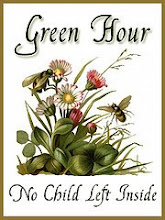Before I fell in love with Steiner I was very interested in Montessori education. There are many things the two philosophies have in common, but one of the areas they part ways on is ‘fantasy’.
In The Absorbent Mind” Maria Montessori talks about children’s love of fantasy, magic and pretend play as if it was a sign that something was wrong. Too much ‘pretend’ play should be discouraged, and children gently brought back into the ‘real’ world. This was something I could never quite get my head around. If any Montessorians are reading this and wish to comment, I’d love to hear from you.
Steiner on the other hand sees that the first seven years are ripe for imaginative play, and that a rich fantasy life should be encouraged to develop children’s full creative potential. This seems to be born out by modern science, in fact a whole episode of Child of Our Time was recently devoted to the development of creativity and the ‘crisis’ around seven years when the real world comes crashing in.
I remember as a child being very deeply in 'fantasy'. I had an imaginary friend, I had passionate relationships with my dolls. My aunty remembers giving me a small play-horse and says that I took it into my room and held it up, turning it around and staring at it in awe. I would love Munchkin to have the same love of fantasy that I had, and find Steiner philosophy full of wonderful ideas to encourage this.
In ‘You are your child’s first teacher’, Rahima dedicates a whole chapter to developing fantasy and imagination. Dolls, toys, fairytales and nursery rhymes are all important parts of this. She explains that “Everything the young child takes in makes a profound impression on him”. So quality toys, made of natural materials, and that are ‘open ended’ so children can play with them in a myriad of ways are the ideal. I have seen this at playgroup where a circle of rough wood becomes a plate, a hat, a shield, a wall, a door … all in the space of a morning. A piece of blue coloured muslin becomes the sky, the sea, a curtain, a blanket, a peekaboo device.
Dolls play a particular role in Steiner play. Rahima writes that “We need to put our attention into the quality of the dolls our children have. Not only their expression is important, but the quality of the material as well. Is the doll hard and cold or soft and huggable? Is the hair platinum and grotesquely matted after a week’s play? A soft cloth doll with yarn hair and a neutral expression provides the child with a companion who can change as she does… Barbie is a multimillion dollar enterprise and encouraging our young children to indulge in her designer jeans and convertible supportive values that impoverish the world of the young child”
And Fairy Tales and Nursery Rhymes are also very ‘Steiner’. I always had a problem with Fairy Tales, and I still hate the Hansel and Gretel tale, and Cinderella. Children being treated badly and alone in the world made me hugely sad as a child, and today. Rahima says to simply avoid stories that bring out these feelings in you as an adult, because your fear will be transmitted to children. However, she suggests a wide range of lovely Fairy Tales, that are actually very sweet.
For three year olds she suggests
Sweet Porridge
Goldilocks
Little Tuppens
Little Louse and Little Flea
The Turnip
The Mitten
The Gingerbread Boy
The Johnny Cake
The Hungry Cat
And my last comment on this, rather long and drawn out post, is to dismiss any myth that Steiner parents don’t read to their children. While making up your own stories is strongly encouraged, I had a discussion with a woman from the Steiner Federation here who said that we should ‘fill our children’s lives with books’ and continue reading to them not only as babies, but right up in to their teens. Wise lady that.
Initially posted at http://domesticallyblissed.wordpress.com/2008/03/15/fantasy/
Raw Cauliflower Salad
15 years ago






No comments:
Post a Comment